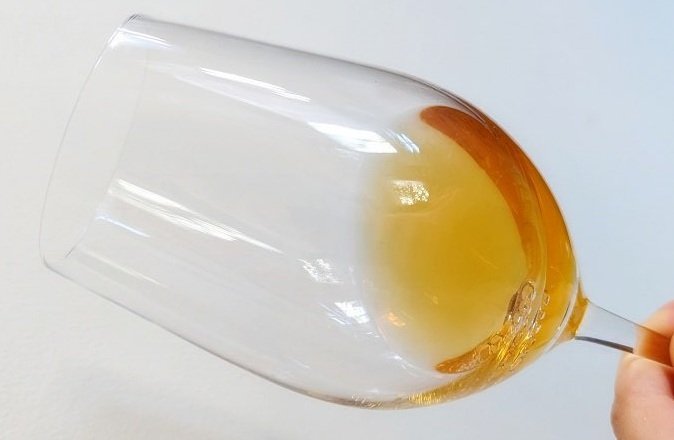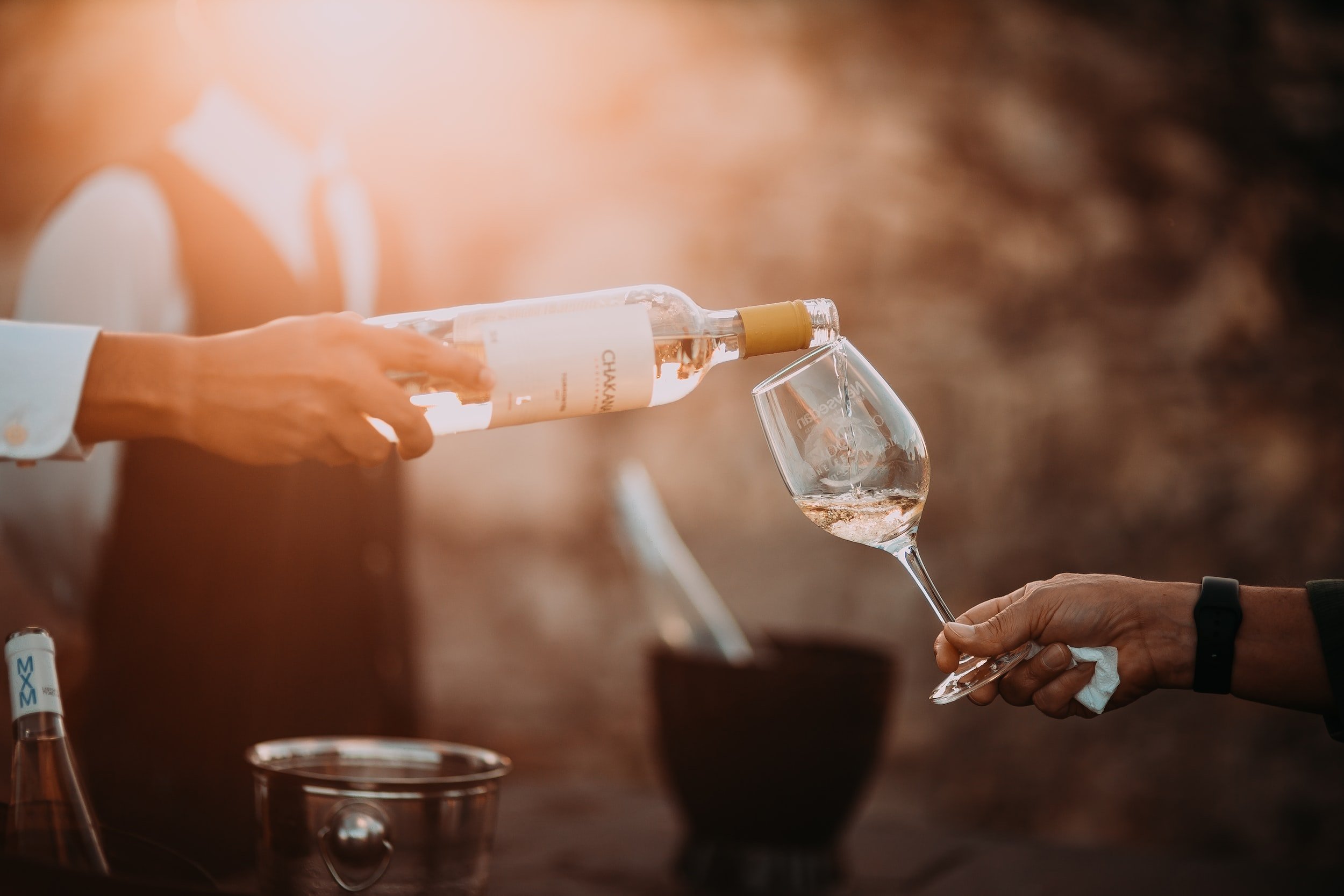
You’ve heard of rosé wine (and probably enjoy it as much as I do), but what about orange wine? How does it compare to rosé and just what is it doing your wine glass?
Orange wines are made using white wine grapes (like Chardonnay), and rose wines are made using red wine grapes (like Pinot Noir). The grape juice for rose wines has limited skin contact during winemaking, which makes them pink. The grape juice for orange wines spends significant contact time with the grapes’ skins, turning the wine orange.
Here’s what you need to know about the difference between orange wine vs rose.
Orange Wine
Orange wine has been around for thousands of years and has a cult following among wine enthusiasts worldwide.
How Are Orange Wines Made?
Despite its name, orange wine isn’t made from oranges. It’s made from grapes – white wine grapes, to be more precise.

Orange wines are made using white wine grapes, but instead of making white wine, winemakers follow the traditional method used to make red wines.
Fun Nerdy Wine Fact: Most wine grapes have a clear pulp (juice). This means that the color of the wine you see in your glass comes from the grapes’ skins, which have color compounds called polyphenols.
The winemaker takes the white wine grapes from the vineyard and crushes them (squishes them to release the juice), then sets the crushed grapes aside in a container, like a stainless steel tank, barrel, or clay jar to start the fermentation process.
Helpful Tip: Here’s a geeky post on how wine fermentation works. It’s not for everyone, but maybe it’s for you.
If this were a normal white wine, then the winemaker would press all of the grapes immediately to separate the juice from the skins, leaving the clear juice behind.
But because this is an orange wine, the winemaker will keep the juice and skins together for a period of time – anywhere from a few weeks (through the end of fermentation) to a year. This contact time between the juice and the skins extracts color and tannin (tannin’s that drying sensation in your mouth you feel when you drink red wine), along with some fabulously complex flavors.
Helpful Tip: Here’s a comprehensive overview of orange wines – how they’re made and what they taste like. Check it out!
Characteristics of Orange Wine

Orange wines have more body and tannin with a grippyness to them that rosé wines lack. Expect strong citrus notes, wood varnish, bruised fruits, herbs, and dried nuts and flowers. These wines are pungent, and some describe them as funky, which can be off-putting if you’re not used to earthy wines.
Orange wines from different producers will have unique flavor and aroma profiles depending the how the winemaker treated the grapes in the winery and what grapes were used in the wine.
Orange wines can have a range of tree, stone, and citrus fruit, floral notes, and spice. Here are a few tasting profiles of orange wines:
- Fresh pears, apricot preserves, white pepper
- Clementines, white jasmine tea, spice
- Orange blossom, honeysuckle, potpourri, chamomile
- Peach, orange rind, white flowers
- Mineral, green tea, apricot oil
Food Pairings for Orange Wine

Orange wines have more structure and spice to them than your typical rose wine, so they make versatile pairing partners.
The grippy tannins, which winemakers usually try to avoid in rose wines, give orange wines a savory depth of character, making them great pairing partners for foods with flare. Here are some foods that go with orange wine:
- Pizza with spicy sausage or red pepper flakes
- Panini sandwiches
- Low country boils
- Cioppino
- Enchiladas
- Nachos
Rosé Wine

Rose wines are pink wines made from red wine grapes, like Pinot Noir, Grenache, or Carignan.
How Is Rosé Wine Made?
Winemakers take the red grapes from the vineyard and crush them, releasing the white grape juice. They leave the red skins and white juice in the same container (maybe stainless steel or plastic bin) for anywhere from a few hours to a few days.
The longer the juice and skins stay in contact together, the deeper pink your rosé wine will be.
Some winemakers want very pale blush wines, and others aim to make vibrant fuchsia rosé wines. The color of rosé wine depends 100% on the style of wine the winemaker wants to make.
Helpful Tip: Here’s a post that goes into how rose wines are made that you may be interested in (it even has a 3-minute video).
So, what’s the difference in winemaking between orange and rosé wines?
Winemakers limit contact with the grape skins during winemaking for rose wines, and deliberately maximize skin contact when making orange wines.
Characteristics of Rose Wine

Rose wines have a lighter body, higher acid, and no (or low) tannins than their red wine counterparts. Rosé wines tend to be fruity, easy-drinking wines that should be enjoyed the same year they’re made.
Helpful Wine Buying Tip: If you have the choice between buying a bottle of this year’s rosé wine or last year’s rosé wine, always pick this year’s.
Rose Food Pairings

Light wines call for lighter foods. Think summer salads, pasta salads, white fish, herbed meats, summer soups, sushi, spring rolls, and everything fresh.
Orange Wine vs Rose Wine
Orange and rosé wines couldn’t be more different.
Differences in Color: Orange Wine vs Rose
Starting with the obvious difference in color, orange wines will be visibly amber or orange. Rose wines will always be a shade of pink – vibrant or soft, you’ll see blush in your glass.
Does Orange Wine Taste Like Rosé?
No, orange wine doesn’t taste like rose. Orange wines have a bite to them, including spice, tannin, and strong savory aromas. Rose wines, in contrast, forefront bright red fruits, floral notes, and citrus or melon with no noticeable tannins for an easy-drinking experience. In addition to the color difference, the taste profile for both orange wines and rosé wines is distinctive.
Differences in Food Pairing: Orange Wine vs Rose
Rose wines are go-to pairing partners with lighter, uncomplicated meals: Summer salads, roasted vegetables, grilled meats, and poached fish. Orange wines demand dishes of substance. Go with depth and spice – tacos, paninis, pizza, meatloaf, onion rings – think hearty.
If rosé wine is your summer pairing partner for an afternoon on the patio, orange wine is your companion for pizza and political debates – give your orange wine something to hang onto while you swirl and sip.
Differences in Popularity and Availability: Orange Wine vs Rose
Two of the biggest differences between rosé and orange wine are popularity and availability. Rose wines enjoy widespread popularity and you can find them anywhere wines are sold.
Rose wines are affordable for any wine budget.
Orange wines, on the other hand, are not widely available. Their unique flavor profile makes them less popular, and therefore harder to find. You’ll have to seek out a specialist wine shop that stocks orange wines, a winery that makes orange wines, or find an online store that can ship orange wines. Orange wines target a specific wine consumer who understands and appreciates the layered complexity of these unique wines.
Orange wines will cost more than rosé wines.
Orange wines are more expensive due to additional winemaking costs (they spend more time on the grape skins and need additional monitoring) and because they tend to be small, artisanal production wines.
Final Thoughts – Orange Wine vs Rose

The differences between orange wines and rosé wines start with the grapes and continue through the winemaking process.
- Orange wines are made with white wine grapes. Rose wines are made with red wine grapes.
- Orange wines maximize skin contact and tannin extraction. Rose wines minimize skin contact for a clean, fruity profile.
- Orange wines have depth, spice, and sometimes funky characteristics. Rose wines forefront fresh red fruity, crunchy citrus, and a bright acid structure.
- Rose wines pair well with light, fresh foods, like salads and white fish. The tannin structure and earthy notes in orange wine make them suitable pairing partners for hearty dishes, like grilled meats or pasta with tomato sauces.
- While rosé wines enjoy widespread availability making them an affordable everyday wine style, orange wines have limited production from artisanal producers specializing in this unique wine. You’ll end up spending more for orange wine than rosés.
Fun Side-by-Side Tasting Challenge: Orange wine vs Rose wine

A great way to learn about wines is to do a side-by-side tasting challenge.
- Buy 1 bottle of orange wine and 1 bottle of rosé wine.
- Buy 2 kinds of cheese: a smoked cheese and a soft cheese (like goat cheese)
Pour yourself a glass of each and think about the following questions:
- What’s the color difference between the two wines?
- What do you smell in each wine? (the rosé should leap out of the glass with fresh fruit aromas, and the orange wine should smell more savory, with spice and earth)
- Which wine has more weight? Take a sip of each and hold it in your mouth. (the orange wine should feel heavier on your tongue)
- Which wine has more tannin? (Here’s a 30-second tasting tip on how to taste tannin in wine)
- Which wine pairs better with the 2 styles of cheese?
Ultimately, both rosé and orange wines have a place in the world of wine. You may discover that you have a newfound love for funky and fun orange wines, or you may decide that the classic clean pink wine is for you.
Like so many things in life, there’s no one right answer for everyone and it comes down to personal preferences. You do you!
Thirsty for More?
Here’s a helpful post that goes over how much you should be paying for a bottle of rose wine. Worth a read.
Curious about orange wines? Here’s a post that compares natural orange wine to conventional orange wine. Yes, there’s a difference.
Orange wine comes in several different styles, check it out!



